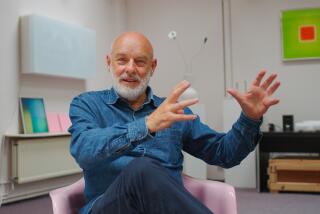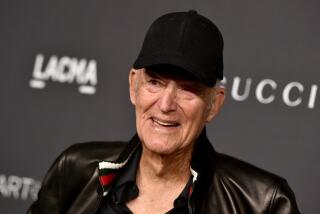The Accidental Genius
- Share via
It’s 3:30 in the morning at Kitt Peak National Observatory in Southern Arizona, where the world’s largest collection of optical research telescopes eyeballs the cosmos above the star-bright Sonoran desert. For the past hour I’ve been standing in blindfold darkness at the foot of the Mayall 4-meter telescope, a silver-lidded giant moaning as it slews from one celestial target to another.
It’s an odd fact of history that the man who most helped us understand the universe did not spend a lot of time looking up at it. In 1938, Albert Einstein gave his dusty and unused telescope to his accountant to thank him for keeping the Internal Revenue Service off his back. That telescope is included in the Skirball Cultural Center’s current exhibit “Einstein,” one of a strange and random constellation of events celebrating the centenary of the physicist’s annus mirabilis. In 1905, Einstein, an anonymous 26-year-old patent office bureaucrat, wrote five papers on fundamental physics that changed the world and put Sir Isaac Newton out of the cosmology business for good. At a stroke, Newton’s vision of the universe as a vast three-dimensional emptiness ticking away to God’s pocket watch was dispatched by Einstein’s surreal, intellectually sexy notion of space-time.
The United Nations has proclaimed 2005 the International Year of Physics, with Einstein the woolly-headed poster child. Last month in Los Angeles, the American Physical Society devoted much of its annual convention to Einstein exegesis. Einstein was Time magazine’s “Person of the Century” in 1999, and as if that wasn’t honor enough, Will Ferrell appeared on the cover of Esquire’s 2003 “Genius” issue in spatchcocked white wig and nebulous eyebrows, the “Einstein of Comedy.” Einstein’s mom would be so proud.
Now he’s the subject of dozens of books, including the new, not-so-dispassionately titled “Einstein 1905: The Standard of Greatness,” by John Rigden. And the Pirelli tire company is offering 25,000 Euros for the best explanation of relativity lasting five minutes or less.
Even though he died in 1955, Einstein is experiencing Lindsay Lohan-like levels of overexposure.
It’s worth considering what people mean when they call Einstein an icon, which they do when they aren’t calling him a rock star: an instantly recognizable image, a symbol--but of what, exactly?
Americans don’t make heroes of their intellectuals the way, say, the French do. When the confounding new wave philosopher Michel Foucault died in 1984, Paris was thrown into a week of mourning. When the Harvard biologist Stephen Jay Gould died in 2002, Cambridge calmly sailed on.
It seems that in our cultural pantheon there is only one pedestal marked “scientific genius,” and that position has been filled. There are no coffee mugs with Niels Bohr’s picture on them, no dorm-room posters with Werner Heisenberg riding a bicycle. Yet there is Einstein on the cover of the “Oxford Dictionary of Scientists,” benign and bemused and bed-headed. To the extent that other cosmologists have risen to public recognition, they have also been defined by a certain otherness--Stephen Hawking in his wheelchair, Carl Sagan in his turtlenecks. When it comes to explaining space and time, only aliens will do.
Einstein is as close to a scientific saint as we have, even to the point that his brain was removed and put in a Tupperware reliquary by a rogue pathologist, Dr. Thomas Harvey. Decades later, Einstein’s brain, along with Dr. Harvey and writer Michael Paterniti, made a cross-country trip in a Buick Skylark, a journey chronicled in Paterniti’s bizarre 2000 book, “Driving Mr. Albert.”
The beatification of Einstein is partly driven by his personal narrative of redemption. In school, little Albie Einstein was lazy and bored, specializing in the thermodynamics of chair-warming. Then, shazaam, he’s the smartest man in the world.
Even when he was wrong, he was more right than he knew. In 1917, Einstein created something he called the “cosmological constant,” which was basically a fudge factor to make his calculations of a fixed universe come out right.
Lo and behold, a decade or so later, Edwin Hubble and others demonstrated that the universe was not fixed but expanding, much to Einstein’s embarrassment. He called it his “greatest blunder.” And yet the biggest mystery in cosmology today is “dark energy,” an idea Einstein first proposed to explain away his book-cooking.
Curiously, even as more Americans embrace a supernatural explanation of Creation, Barnes & Noble bookshelves are groaning with the weight of books about physics and cosmology, such as Roger Penrose’s magnificent, daunting “The Road to Reality.” The continuing fascination with Einstein may mean nothing more than that secularists need their own white-haired patriarch in the sky.
Up at Kitt Peak, the sky is cold and black and shot through with white and pastel stars and, now and then, a furious, silent meteor.
Dr. Einstein, I presume?
More to Read
Sign up for Essential California
The most important California stories and recommendations in your inbox every morning.
You may occasionally receive promotional content from the Los Angeles Times.













